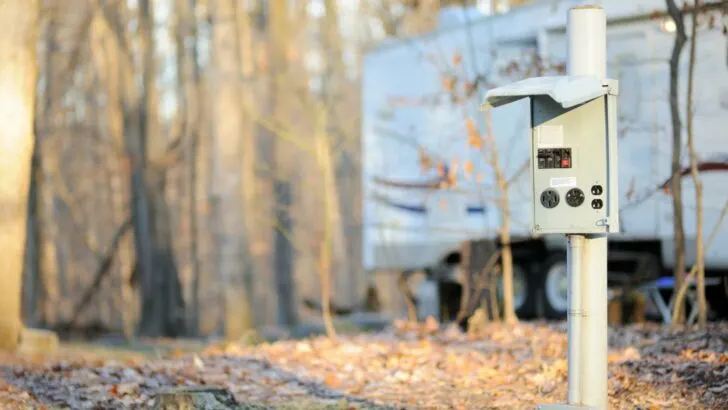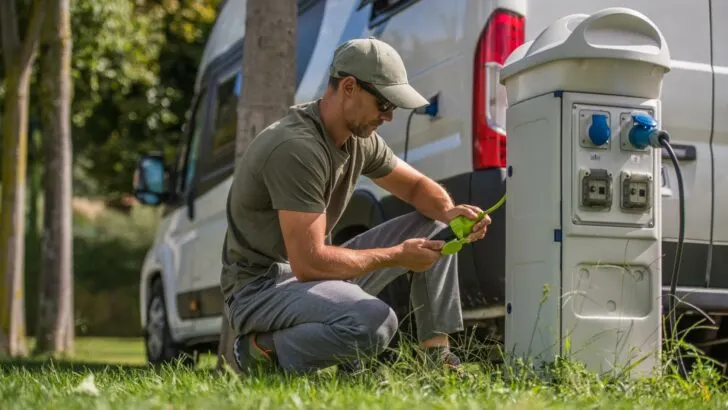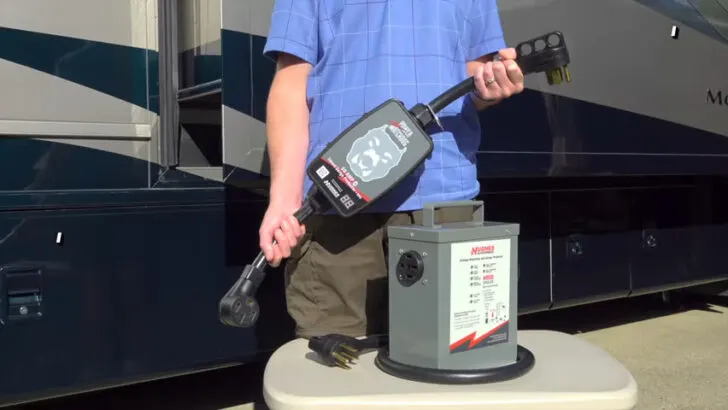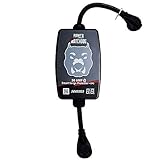A quality, highly protective RV surge protector can appear at first glance to be a bit pricey. But when you consider the cost of replacing your RV’s electronics, the cost of surge protection becomes inconsequential.
Plugging your RV into unknown power sources like those at RV parks, campgrounds, state parks, etc. is always risky. Any power pedestal could have issues that even the park owner isn’t aware of yet. When you consider the large number of power sources we connect our RVs to, a high-quality surge protector is an absolute must.
Today we’re taking a look at the best RV surge protectors to keep your RV and its electronics well protected from surges and other power issues.
What Is an RV Surge Protector?
A good RV surge protector offers protection from an electrical surge that can come through the power pedestal into which an RV is plugged. An electrical surge can damage RV electronics and appliances (both those that came with the RV, and anything plugged into a 120V AC outlet).
A good RV surge protector effectively manages and protects your electrical system.
A high-quality RV surge protector has the ability to cut the power coming in from the power pedestal automatically when any dangerous electrical event occurs.
A good surge protector will also automatically restore power to your RV once power is detected as being safe and the electrical event is no longer a threat.
And finally, some high-quality RV surge protectors will even display the fault so you’ll know exactly what electrical event took place to cause the unit to shut down the power coming into your RV from the power pedestal.
A really good RV surge protector, then, is more of an electrical management system.

Any time you plug your RV into a power pedestal at a campground, RV park, or anywhere else, you need protection for your RV’s electronics as well as your RV appliances. Without protection, one bad pedestal or one rogue electrical event could not only fry the electronics on board your rig but could even start a fire.
What Kinds of Electrical Events Can an RV Surge Protector Protect Your RV From Experiencing?
There are a number of things that can occur when your RV is plugged into a power pedestal at a campground, RV park, or anywhere else. These types of electrical events don’t only occur when a power pedestal is poorly maintained (though that can also happen). These events can occur at just about any power source into which you plug your RV.
You’re probably aware that an RV surge protector will protect your rig from voltage spikes (surges).
However, a high-quality unit may also be able to protect your RV from all or some of the following:
Voltage/Power Surges
Any interruption in the power grid is capable of causing a power surge. This could happen when lightning strikes a power line, for example. If powerful enough, a power surge could fry every electronic device and appliance in your RV, which is why a surge protector is extremely important.
Low Voltage
Low voltage can occur in a crowded RV park when many RVers are using the electricity supplied by the park. An example of this might be in the dog days of summer when every RV plugged into the park’s power source is running (one or more of) their AC unit(s) to keep cool.
We often think of low voltage as being a far lower risk than a voltage spike, but in fact, low voltage can damage sensitive electronics such as those in our RV technology cabinet as well as AC units and heat pumps.
So, a good RV surge protector will protect your RV’s electronics from both high and low voltage.
Reverse polarity
Current should flow through the hot wire at the pedestal into your electronics, appliances, and receptacles.
Reverse polarity occurs when a power pedestal or receptacle is wired backwards. This means that the hot wire (the black or red wire) is connected to the neutral side, and the neutral wire is connected to the hot side.
This causes the electrical current to flow into your RV electronics and appliances backward, (through the neutral terminal instead of the hot terminal), causing the receptacle, electronic device, or appliance to be energized even if they’re turned off.
This can short-circuit the device causing it to overheat and even shock the user.
Open ground
If the power pedestal at a campground is not properly grounded, your RV can become “electrified” if you have a certain type of electrical issue in your rig such as a frayed wire or a damaged appliance.
See our post on RV hot skin for some very important information on this topic and others related to it.
Open Neutral
The power coming into an electrical power pedestal can be as high as 240 volts (supplied by two separate 120V “hot” wires). The neutral wire in the power pedestal and your RV’s electrical cord is responsible for returning the power from any 120V load(s) (devices or appliances that are using power) back to the source.
If there’s a break of the neutral wire (commonly called an “Open Neutral“) anywhere in the system, a high or low voltage could result, causing damage to your RV’s electrical system and your appliances and devices, and setting up a dangerous situation where you could get shocked.
You can see how important it is to have a high-quality portable RV surge protector to address all of these types of potential issues, especially if you plug your RV into a variety of power sources as you travel.

When you plug your rig into a power pedestal without high-quality surge protection, you’re risking every electronic device, receptacle, and appliance in your RV.
What Do I Need to Consider When Shopping for an RV Surge Protector?
There are a few things you need to know before you shop for an RV surge protector and a few things you want your surge protector to have, so let’s take a look.
Do You Have a 30-amp or 50-amp RV?
First, you need to know whether you have a 50-amp RV or a 30 amp RV so you can match your surge protector. Most reasonably-sized RVs are designed to use either 30- or 50-amp power service (while smaller rigs may have only a 15/20-amp connection, like a standard household plug).
If you’re not sure what type of power your RV is set up for, take a look at your power cord, and then check out our post entitled, “What You Need to Know About Your RV Power Cord” for the answer.
We’ve got photos in that post that you can use to compare with your RV’s power cord. There’s also lots of great information there that you’ll want to understand, particularly if you’re new to RVing.
Do You Want a Portable Unit or a Hard-Wired Unit?
A hard-wired surge protector is permanently installed in line with the shore power cord and may need to be professionally installed.
A portable unit doesn’t need to be installed at all… you simply plug it in between your RV’s power cord and the campground’s power pedestal. But there are a couple of things to consider with portable surge protectors:
- You want them to be secured so that they won’t be stolen
- You also want to protect them from the weather if they aren’t waterproof
What Is the Rating of the Unit?
All surge protectors will indicate the level of protection they provide. That rating is listed in Joules and should be clearly noted on the product box or description. The joule rating is important because it tells you how much energy the surge protector can safely absorb before it will fail.
Any good RV surge protector needs to have a high enough joule rating to protect all of the electronics on board your RV.
Most surge protectors run somewhere in the range from 825 to 3,580 joules. Some (like the Power Watchdogs noted below) offer between 2,400 and 6,100 joules of protection depending on the unit.
What Are the Best RV Surge Protectors?
Let’s take a look at three of the best brands of 30 amp RV surge protectors and 50 amp RV surge protectors to keep you from frying your RV’s electronics, and why they’re the best.
As you’ll see below, we’re putting Hughes in the hands-down #1 position for a reason. During our nearly 20 years of full-time RVing, we’ve owned two RVs and a number of different surge protectors. Once we discovered Hughes, there was no going back to lesser brands.
To this day, we trust Hughes to protect our rig. We think it’s simply the best on the market, which is why we never, ever plug into power without it. Of course, we have a 50-amp model because we have a 50-amp RV. But 30-amp models are available, too, and protect 30-amp RVs the same way.
We’re so happy with our Hughes equipment, that we’ve arranged with Hughes to offer a special discount to RVgeeks readers. Keep reading for complete details!
Hughes Power Watchdog 30-Amp Bluetooth Surge Protector with Auto Shutoff
The Hughes Power WatchDog is the world’s first advanced Smart RV surge protector with emergency power off (EPO).
There are a number of Hughes Power Watchdog models with various features at various price points. We not only recommend the Hughes Power Watchdog as our top choice, but we also recommend getting a unit with EPO as that automatic power-off is a very important feature.

The Power Watchdog is a substantial unit and a very protective electrical management system. Here’s John holding our 50-amp Hughes Power Watchdog with EPO.
What this means is that your Watchdog will automatically shut down (disconnecting all shore power to your RV) in either a low or high voltage condition, (if voltage falls below 104 volts or rises above 132 volts). This protects the electronics and appliances in your RV from these low or high-voltage conditions. Other brands may simply warn you of that condition… or, worse yet, don’t have this feature at all.
Once power conditions stabilize for at least 90 seconds, the unit will automatically turn back on, allowing power to flow to your RV again.
In addition to EPO, this model of the Watchdog offers a number of desirable features:
3,000 Joules
This 30-amp Power Watchdog Smart Surge Protector offers 3,000 Joules of advanced surge protection and automatically shuts off power in the event of an emergency. Please note that it appears that the 30-amp model with 3,000-joule protection is only available directly through Hughes here. (There are other units on Amazon, but at the time of the writing of this post, the models offered on Amazon offer only 2,400 joules of protection.)
Replaceable Surge/Spike Module
The Power Watchdog has a replaceable surge/spike module which is not something you’ll often find in most other RV surge protectors. So, if your rig gets hit with a large electrical surge and the surge module sacrifices itself to protect your RV’s electronics (which is what it’s supposed to do!), you don’t have to replace the entire surge protector. You can simply buy a new surge/spike module from Hughes for a fraction of the price and replace it yourself.
Real-Time Smartphone Monitoring
You can actually monitor electrical conditions at your power pedestal on your smartphone via Bluetooth using the free mobile app provided with the Watchdog. The ability to monitor voltage, amperage, and wattage in real-time is a great feature to have. The wireless fault alerts sent right to your smartphone make you aware of any hazardous power conditions at the power pedestal.
User-Friendly
The Power Watchdog is very easy to use. It only takes about 4 seconds to power on and determine if the power conditions are safe. It has a built-in 90-second power-on delay so the Watchdog has time to detect and resolve any potential faults in the system.
Compatible With “Dogbone” Electrical Adapters
All Power Watchdog models (as all surge protectors) are compatible with dogbone adapters. (See our “Dogbones 101: Plugging In an RV post for more information on dogbone adapters.)
Remote Monitoring Available (with RVWhisper)
There’s an option to add remote monitoring capabilities to your Watchdog by using an additional device from RVWhisper. Their remote monitoring system allows you to keep track of your RV’s temperature, shore power, battery power, propane, and security from many miles away. (For example, when your rig is in storage or when you’re miles away from the rig hiking or otherwise enjoying nature.)
To use this capability, you’d need to also purchase the RVWhisper system:
- PET SAFETY EARLY WARNING. The included wireless battery voltage sensor detects shore power loss BEFORE it gets hot in the RV.
- Unlimited text and email alerts
The Hughes 30-Amp Power Watchdog can be purchased directly from Hughes here. When you order, be sure to use our RVgeeks discount code for 10% off!
Make sure your RV is protected from low voltage, bad RV park wiring AND power surges when connecting to shore power with a Power Watchdog and/or Hughes Autoformer. We never hookup without ours (we...Show More
Make sure your RV is protected from low voltage, bad RV park wiring AND power surges when connecting to shore power with a Power Watchdog and/or Hughes Autoformer. We never hookup without ours (we have both), and know our RV's electrical system and all our electronics are being protected.
Watch our Hughes Autoformer video
Watch our Hughes Power Watchdog video
Save 10% on your entire purchase when ordering from Hughes!
Show LessThere are a number of versions of the Hughes Power Watchdog on Amazon (some of them may be older models), so you’ll need to check the features of any you find and make sure you’re getting all the features you want in an RV surge protector.
We’ll link to a couple of Amazon’s choices here and encourage you to read the features, specs, and reviews, as always. For example, the 30-amp Watchdog we’re linking to on Amazon only offers 2,400 joules of protection as compared with the newer version (purchased directly through Hughes) offering 3,000 joules.
- Replaceable Surge / Spike Module: Should a large spike happen, surge module is completely replacable instead of replacing the entire unit.
- Wirelessly Monitor voltage, amperage, and wattage on your smartphone in real time using our free mobile app! Oldest and most reliable phone app in the...
Here’s the hard-wired version of the 30-amp model with EPO (also with 2,400 joules):
- Replaceable Surge / Spike Module: Should a large spike happen, surge module is completely replacable instead of replacing the entire unit.
- Wirelessly Monitor voltage, amperage, and wattage on your smartphone in real time using our free mobile app! Oldest and most reliable phone app in the...
Hughes Power Watchdog 50-Amp Bluetooth Surge Protector with Auto Shutoff
The Hughes Power Watchdog is available in a 50-amp model as well. It has all the same great features of the 30-amp version noted above including EPO and Bluetooth, but it offers 6,100 joules of advanced protection for those of us with 50-amp RVs.
You can purchase the 50-amp EPO version directly through Hughes here, or you can take a look at the versions Amazon has to offer and check out the reviews while there.
Please note that as of this writing the difference in the 50-amp EPO models of the Power Watchdog on Amazon appears to be limited to 4,800 joules of protection (compared with 6,100 on the units purchased directly through Hughes).
- Replaceable Surge / Spike Module: Should a large spike happen, surge module is completely replacable instead of replacing the entire unit.
- Wirelessly Monitor voltage, amperage, and wattage on your smartphone in real time using our free mobile app! Oldest and most reliable phone app in the...
A hard-wired version of the same 4,800-joule model is also available via Amazon:
- Replaceable Surge / Spike Module: Should a large spike happen, surge module is completely replacable instead of replacing the entire unit.
- Wirelessly Monitor voltage, amperage, and wattage on your smartphone in real time using our free mobile app! Oldest and most reliable phone app in the...
Southwire Surge Guard
Another quality RV surge protector is the Southwire Surge Guard, also available in 30-amp and 50-amp versions.
A bit more expensive than the Power Watchdog, the Southwire Surge Guard offers 2,450 joules of protection in the 30-amp version and 4,200 joules in the 50-amp version. Complete protection with both line and load monitoring is available, and all units offer automatic reset when power is restored after an event has occurred.
These units are easy to use, and Southwire now offers an optional (extra cost) battery-operated Bluetooth LCD display that allows for remote monitoring of your Surge Guard (similar to how the Hughes Power Watchdog allows you to use an app on your smart devices for monitoring).
Southwire’s Surge Guard 30- and 50-amp models, as well as the separate Bluetooth display, are available through TechnoRV here, and you can save 5% by using the RVgeeks discount code:
TechnoRV.com is a supplier of leading RV technology products that are designed to enhance your RV lifestyle. That includes items like LevelMatePRO, Viair portable air compressors, connectivity...Show More
TechnoRV.com is a supplier of leading RV technology products that are designed to enhance your RV lifestyle. That includes items like LevelMatePRO, Viair portable air compressors, connectivity equipment, and more!
Use the Promo Code "RVGEEKS" to save 5% on your entire order at TechnoRV.
Show LessThey’re also available on Amazon, but once again – be sure to take a look at the specs and reviews to make sure you’re getting the surge guard product you want and need.
Here’s a 30-amp version:
- Continuously monitors for and displays voltage and amp draw (RMS)
- LCD display (English)
And here’s a 50-amp Surge Guard:
- Commercial-grade, brass receptacle
- Automatic reset on power restoration
And, lastly, the Bluetooth LCD display is available here:
- Optional Bluetooth LCD screen compatible with Surge Guard models 34931 and 34951
- Provides detailed information regarding voltage, amp draw, frequency, kilowatt usage, current fault screen, fault log (previous four faults), and...
Progressive Industries 30-Amp or 50-Amp EMS
The Progressive Industries EMS (Electrical Management Systems) units are available for both 30-amp and 50-amp RVs.
Progressive Industries has a variety of EMS units from which to choose, all of which offer either 3-mode or 5-mode surge protection. They offer both hardwired options as well as all-in-one portable surge & testing units.
These models offer anywhere from 1,650 to 3,580 joules of surge protection for your RV. All models will protect from open hot, open ground, open neutral, and reverse polarity situations, and all of them come with a lifetime warranty (with the exception of the Weather Shield protective housing).
You can find all of the Progressive Industries portable and hardwired options available on their website or on Amazon.
We’ll link to a couple of 30-amp and 50-amp Amazon options here, reminding you once again to check capacities, features, and reviews carefully.
- Maintain electronic safety - This 30 Amp RV Surge Protector by Progressive Industries is a real guard for your RV electronics. Its built-in Electrical...
- Prevents costly damage - With a 30A/120V/3,600W rating, EMS-PT30X can absorb surges of up to 1,790 joules. This surge protector prevents severe and...
- Maintain electronic safety - This 50 Amp RV Surge Protector by Progressive Industries is a real guard for your RV electronics. Its built-in Electrical...
- Prevents costly damage - With a 50A/120-240V/12,000W rating, EMS-PT50X can absorb surges of up to 3,580 joules. This surge protector prevents severe...
We invite you to check out our ultimate RV electrical system protection to see how we’ve chosen to protect our motorhome using a Hughes Power WatchDog in conjunction with a Hughes Autoformer.
Geek Out with Us Every Week
Join our newsletter to learn about all things RV-related. Every week we offer free tips, tricks, product reviews, and more to our online community of RVers. So, whether this is your first time on the road or you’re a seasoned expert, we’d love for you to geek out with us!














Steve L.
Monday 14th of August 2023
I have been attempting to purchase a Hughes surge protector for weeks. The site appears to be shutdown. I’ve called the company and left messages, and no one calls me back. Are we sure they are still open?
I enjoy everything you two do for the rving world, from your newsletters to The RVers, you’re fabulous. I can’t wait to see what new rig you purchase.
TheRVgeeks
Monday 14th of August 2023
Hi Steve. Sorry to hear about your issue. As far as we know, they ARE still in business... and we just tried going through the process on their website and it all seems to be working for us. Are you sure you've got the right site (https://hughesautoformers.com)? We're able to add a unit to our cart, and proceed all the way to the point of actually clicking to complete the process and it's working.
If that still doesn't work for you, you could try using a different browser or another device. Or, you could order through another retailer like Amazon or MobileMustHave.
Fernweh Ric
Thursday 25th of August 2022
Hi RV Geeks! I have a Progressive Industries EMS-PT50X that I use on my Prevost XL40. It has 3 Cruisair conditioners. I have noticed that if the Surge protector catches an over power or under power it disconnects me. That being said, once that condition is gone it only takes a little over 2 minutes for power to return. Couldn’t that cause a short cycle condition for the AC's? Most AC information says you need to keep the compressor off for 7 to 10 minutes between cycles. Am I missing something? Best Regards, Fernweh Ric
Fernweh Ric
Saturday 27th of August 2022
@TheRVgeeks, Thanks you two! Wasn't sure if there was a difference between house and RV. Happy travels!
TheRVgeeks
Thursday 25th of August 2022
Hi @Fernweh Ric... we've never heard of needing that large a waiting period between cycles for an RV air conditioner. Larger, household units (or industrial air conditioners) may need 7-10 minutes to allow the pressure to bleed back off. But RV air conditioner compressors and coolant loops are fairly small. So 2 minutes is what we've always heard as being the safe time between a premature shutdown and restart. So you should be just fine. Your Progressive Industries unit sounds like it's doing it right.
Mike
Tuesday 16th of August 2022
We are purchasing a Tiffin that has a built in surge protector. In general, are these factor-installed surge protectors adequate protection?
Mike
Thursday 18th of August 2022
@TheRVgeeks, THANKS!
TheRVgeeks
Wednesday 17th of August 2022
Hi Mike. It depends on which unit they’re installing (we’re not familiar with what Tiffin is using these days). Most often, it’s some basic surge protection installed as part of the transfer switch (that transfers the incoming power between the shore power cord and the generator, if it’s running). But those often don’t include the other features like high/low voltage protection and/or the other circuit checks/protections that the dedicated units offer. So we’d suggest looking into what make/model/style of surge protector that Tiffin is putting into the coach and determine what it offers… and if you think it’s enough to keep you safe.
Mark K.
Monday 15th of August 2022
Hello RV Geeks and Fellow RVers,
I have a Progressive Industries EMS-PT30X for my 2018 Forest River Sunseeker Class C. I purchased it in 2019 and used it for two years without any problems. Then I started having problems with the unit giving strange error messages. It then failed completely, with no power coming out of the unit even though there were no problems detected with the incoming power. Since the unit has a lifetime warranty, I filled out the warranty claim form at their website (www.progressiveindustries.net). I received a reply a couple of days later informing me that my claim was approved and about a week or so later, I received a new Surge Protector. I was not even required to return the old unit. I just wanted to give kudos to Progressive for honoring their warranty and for excellent customer service.
TheRVgeeks
Wednesday 17th of August 2022
Hi Mark. Glad to hear that Progressive stood behind the unit!
John S.
Monday 15th of August 2022
In the photo ". . . . Here’s John holding our 50-amp Hughes Power Watchdog with EPO." you have a Hughes Autoformer on the table.
Which I bought after watching this: https://www.youtube.com/watch?v=deQUv5pHLYA&t=4s
Are these still being made? Why not mention it in this article?